Geo-Analysis of Compatibility Determinants for Data in the Land and Property Register (LPR)
Abstract
:1. Introduction
2. Literature Review
2.1. Origin of the Data in the Polish Land and Property Registry (LPR)
2.2. Legal and Technical Procedures Which Enable Changes in the Land and Property Registry
3. Materials and Methods
3.1. Methodology, Data Collecting and Analysis
3.2. Description of Area Research
4. Results
5. Discussion
6. Conclusions
Supplementary Materials
Author Contributions
Funding
Conflicts of Interest
References
- Williamson, I.P.; Grant, D.M. United Nations-FIG Bathurst Declaration on Land Administration for Sustainable Development: Development and Impact. FIG XXII International Congress 2002, Geomatics and Property Valuation for Global Sustainable Development. Session TS7.5. Available online: http://www.csdila.unimelb.edu.au/publication/conferences/UN_Fig_BathurstDeclaration.pdf (accessed on 10 May 2019).
- Rajabifard, A.; Williamson, I.; Steudler, D.; Binns, A.; King, M. Assessing the worldwide comparison of cadastral systems. Land Use Policy 2007, 24, 275–288. [Google Scholar] [CrossRef] [Green Version]
- Bennett, R.; Rajabifard, A.; Kalantari, M.; Wallace, J.; Williamson, I. Cadastral Futures: Building a New Vision for the Nature and Role of Cadastres. International Federation of Surveyors. FIG Peer Rev. J. 2010, 4096. FIG Congress 2010, Australia, ISBN 978-87-90907-87-7. Available online: http://www.fig.net/resources/proceedings/fig_proceedings/fig2010/papers/ts08k/ts08k_bennett_rajabifard_et_al_4096.pdf (accessed on 10 May 2019).
- Mika, M. An analysis of possibilities for the establishment of a multipurpose and multidimensional cadastre in Poland. Land Use Policy 2018, 77, 446–453. [Google Scholar] [CrossRef]
- Dawidowicz, A.; Źróbek, R. A methodological evaluation of the Polish cadastral system based on the global cadastral model. Land Use Policy 2018, 73, 59–72. [Google Scholar] [CrossRef]
- Divithure, H.; Tang, C. Evolution of land registration and cadastral survey systems in Sri Lanka. Surv. Rev. 2013, 45, 126–135. [Google Scholar] [CrossRef]
- Lisec, A.; Navratil, G. The Austrian land cadastre: From the earliest beginnings to the modern land information system. Geod. Vestn. 2014, 58, 482–516. [Google Scholar] [CrossRef]
- Shibeshi, G.B.; Fuchs, H.; Mansberger, R. Lessons from systematic evaluation of land administration systems. the case of amhara national regional state of Ethiopia. World Dev. 2015, 68, 282–295. [Google Scholar] [CrossRef]
- Ilyushina, T.V.; Noszczyk, T.; Hernik, J. Cadastral system in the Russian Federation after the modern transformation. Surv. Rev. 2017, 50, 437–446. [Google Scholar] [CrossRef]
- Steudler, D. A Framework for the Evaluation of Land Administration Systems. Ph.D. Thesis, University of Melbourn, Parkville, Australia, 2019. Available online: http://www.geom.unimelb.edu.au/research/publications/PhDThesisDanielS.pdf (accessed on 16 April 2019).
- Çağdaş, V.; Stubkjær, E. Doctoral research on cadastral development. Land Use Policy 2009, 26, 869–889. [Google Scholar] [CrossRef] [Green Version]
- Leitmanová, M.; Bažík, J.; Muchová, Z. New methods for gathering the spatial data from land consolidation project. Acta Sci. Pol. Form. Circumiectus 2015, 14, 125–133. [Google Scholar] [CrossRef]
- Kocur-Bera, K. Data compatibility between the Land and Building Cadaster (LBC) and the Land Parcel Identification System (LPIS) in the context of area-based payments: A case study in the Polish Region of Warmia and Mazury. Land Use Policy 2019, 80, 370–379. [Google Scholar] [CrossRef]
- Hanus, P.; Pęska-Siwik, A.; Szewczyk, R. Spatial analysis of the accuracy of the cadastral parcel boundaries. Comput. Electron. Agric. 2018, 144, 9–15. [Google Scholar] [CrossRef]
- Noszczyk, T.; Hernik, J. Understanding the cadastre in rural areas in Poland after the socio-political transformation. J. Spat. Sci. 2019, 64, 73–95. [Google Scholar] [CrossRef]
- Kilpeläinen, T.; Sarjakoski, T. Incremental generalization for multiple representations of geographic objects. In GIS and Generalization; Lagrange, J., Weibel, R., Eds.; Taylor & Francis: London, UK, 1995; pp. 209–218. [Google Scholar]
- Harrie, L.; Hellström, A.K. A prototype system for propagating updates between cartographic data sets. Cartogr. J. 1999, 36, 133–140. [Google Scholar] [CrossRef]
- Badard, T.; Lemarié, C. Propagating updates between geographic databases with different scales. In Innovations in GIS VII: GeoComputation; Atkinson, P., Martin, D., Eds.; Taylor and Francis: London, UK, 1999; pp. 135–146. [Google Scholar]
- Hu, Y.G.; Chen, J.; Li, Z.L.; Zhao, R.L. Road data updating using tools of matching and map generalization. Int. Arch. Photogramm. Remote Sens. Spat. Inf. Sci. XXXVII Part B 2008, 4. Available online: https://www.isprs.org/proceedings/XXXVII/congress/4_pdf/52.pdf (accessed on 5 March 2019).
- Willrich, F. Quality control and updating of road data by GIS-driven road extraction from imagery. In Proceedings of the Joint International Symposium on ‘Geospatial Theory, Processing, and Applications’, Ottawa, ON, Canada, 8–12 July 2002; Available online: https://pdfs.semanticscholar.org/e07e/8050863dc7b8bc791b8a7547437834ccdb42.pdf?_ga=2.70702480.1090911911.1559565628-257693347.1554364820 (accessed on 10 May 2019).
- Wing, M.G.; Eklund, A. Performance comparison of a low-cost mapping grade global positioning systems (GPS) receiver and consumer grade GPS receiver under dense forest canopy. J. For. 2007, 105, 9–14. [Google Scholar] [CrossRef]
- Wing, M.G.; Eklund, A.; Sessions, J.; Karsky, R. Horizontal measurement performance of five mapping-grade GPS receiver configurations in several forested settings. West. J. Appl. For. 2008, 23, 66–171. [Google Scholar] [CrossRef]
- Danskin, S.; Bettinger, P.; Jordan, T. Multipath mitigation under forest canopies: A choke ring antenna solution. For. Sci. 2009, 55, 109–116. [Google Scholar] [CrossRef]
- Wing, M.G.; Frank, J. Vertical measurement accuracy and reliability of mapping-grade GPS receivers. Computers Electron. Agriculture 2011, 78, 188–194. [Google Scholar] [CrossRef]
- Felcenloben, D. Ocena jakości danych ewidencyjnych oraz efektywności funkcjonowania katastru nieruchomość (Assessment of the quality of register data and the effectiveness of the functioning of the real estate cadastre). Monografie 2015, 181, 203. [Google Scholar]
- Kocur-Bera, K.; Piórkowska, K. The role of the Land Administration System in the process of developing and updating the Land Parcel Identification System—A case study of high nature value farmland in north-eastern Poland. In Proceedings of the 25th Anniversary Conference Geographic Information Systems Conference and Exhibition GIS ODYSSEY, Perugia, Italy, 10–14 September 2018; pp. 252–261. Available online: http://www.gis.us.edu.pl/index.php/conference-proceedings-2018 (accessed on 5 March 2019).
- Siejka, M.; Ślusarski, M.; Zygmunt, M. Verification technology for topological errors in official databases with case study in Poland. Surv. Rev. 2014, 46. [Google Scholar] [CrossRef]
- Geodetic and Cartographic Law of 17 May 1989 (Journal of Laws 30, item 163). Available online: http://www.isap.gov.pl (accessed on 4 March 2019).
- Decree on 2 February 1955 r. On the Registration of Land and Buildings (Journal of Laws 6, item 32). Available online: http://www.isap.gov.pl (accessed on 4 March 2019).
- Instructions on 8 September 1956 on Establishing and Maintaining Land Records, Principles of Drawing up Lists of Land and Fees for Extracts from Maps and for Excerpts and Extracts from Registers and Documents Forming Part of the Registration Survey in the Area of the Capital City of Warsaw, of Lodz and Cities Constituting Poviats (Journal of Laws 98, item 1135). Available online: http://www.isap.gov.pl (accessed on 10 March 2019).
- Cetl, V.; Roic, M.; Mastelic, S.I. Towards a real property cadastre in Croatia. Surv. Rev. 2012, 44, 17–22. [Google Scholar] [CrossRef]
- Directive 2007/2/ EC of the European Parliament and of the Council of 14 March 2007 Establishing an Infrastructure for Spatial Information in the European Community (INSPIRE). Available online: http://data.europa.eu/eli/dir/2007/2/oj (accessed on 14 March 2019).
- Portele, C. Spatial Data Interoperability in INSPIRE. Interactive Instruments. Available online: https://www.paikkatietoikkuna.fi/documents/108478/45ee0d1c-7285-4ae5-9170-7f8ea75411ab (accessed on 24 March 2019).
- Bielecka, E.; Dukaczewski, D.; Janczar, E. Spatial Data Infrastructure in Poland—Lessons learnt from so far achievements. Geod. Cartogr. 2018, 67, 3–20. [Google Scholar] [CrossRef]
- Zwirowicz, K. Selected economic and technical aspects of the use of cadastral data for the purpose of land use. J. Pol. Real Estate Sci. Soc. 2010, 18, 67–75. [Google Scholar]
- Konieczna, J. Agricultural land and updated surveys as the basis of the spatial structure of rural areas. Infrastruct. Ecol. Rural Areas 2012, 1, 197–206. [Google Scholar]
- Regulation of the Minister of Regional Development and Construction on 29 March 2001 on the Registration of Land and Buildings. Available online: http://www.isap.gov.pl (accessed on 3 March 2019).
- Announcement of 3 January 2019 regarding the Publication of a Uniform Text of the Regulation of the Minister of Regional Development and Construction on the Registration of Land and Buildings (item 393). Available online: http://www.isap.gov.pl (accessed on 4 March 2019).
- Balawejder, M.; Świerzb, K. Technology of demarcation the real estate in Poland. In Proceedings of the International Scientific and Practical Internet-Conference of Young Scientists, Lviv, Ukraine, 18 May 2016; Available online: http://www.lnau.lviv.ua/lnau/attachments/3665_Konf_LNAU_18.05.2016.pdf#page=97 (accessed on 15 May 2019).
- The Act of 20 July 2017 Law of Water (item 1566). Available online: http://www.isap.gov.pl (accessed on 4 March 2019).
- Act of 21 August 1997 on Real Estate Management (Journal of Laws 115, item 741). Available online: http://www.isap.gov.pl (accessed on 4 March 2019).
- Malpezzi, S. Hedonic pricing models: A selective and applied review. In Housing Economics and Public Policy; Gibb, K., O’Sullivan, T., Eds.; Wiley Online Library: Madison, WI, USA, 2003; pp. 67–89. [Google Scholar] [CrossRef]
- Combris, P.; Lecocq, S.; Visser, M. Estimation of a hedonic price equation for Bordeaux wine: Does quality matter? Econ. J. 1997, 107, 390–402. [Google Scholar] [CrossRef]
- Baranzini, A.; Ramirez, J.; Schaerer, C.; Thalmann, P. Hedonic Methods in Housing Markets. Pricing Environmental Amenities and Segregation; Springer Nature: Basel, Switzerland, 2008. [Google Scholar] [CrossRef]
- Khalid, H. Spatial heterogeneity and spatial bias analyses in hedonic price models: Some practical considerations. Bull. Geogr. Socio Econ. Ser. 2015, 28, 113–129. [Google Scholar] [CrossRef]
- De Haan, J.; Diewert, E. Handbook on Residential Property Price Indices; Publications Office of the European Union: Luxembourg, 2013; pp. 49–64. [Google Scholar] [CrossRef]
- Wen, H.; Jia, S.; Guo, X. Hedonic Price Analysis of Urban Housing: An Empirical Research on Hangzhou, China. J. Zhejiang Univ. 2005, 6, 907–914. [Google Scholar] [CrossRef]
- Sopranzetti, B.J. Hedonic regression analysis in real estate markets: A primer. In Handbook of Quantitative Finance and Risk Management; Springer: Boston, MA, USA, 2010; pp. 1201–1207. [Google Scholar]
- Cebula, R.J. The Hedonic Pricing Model Applied to the Housing Market of the City of Savannah and Its Savannah Historic Landmark District. Rev. Reg. Stud. 2009, 39, 9–22. [Google Scholar]
- Kocur-Bera, K. Determinants of agricultural land price in Poland—A case study covering a part of the Euroregion Baltic. Cah. Agric. 2016, 25, 25004. [Google Scholar] [CrossRef]
- Potrykus, M. Fancy colored diamonds—Characteristics of investing properties. Wyd. Uniwerystet Łódzki 2017. [Google Scholar] [CrossRef]
- Geoportal, Interactive Map. Available online: www.mapy.geoportal.gov.pl (accessed on 4 June 2019).
- Singh, A.S.; Masuku, M.B. Normality and data transformation for applied statistical analysis. Int. J. Econ. Commer. Manag. 2014, 2, 1–11. [Google Scholar]
- Mierzwa, W. Problems of modernization of land registration system on areas of former Austrian cadastre. Zesz. Nauk. AGH Geodezja 2002, 8, 323–330. [Google Scholar]
- Taszakowski, J. Methodology of Using the Former Austrian Cadastre Maps for Legal Purposes. Ph.D. Thesis, AGH, Poland, Krakow, Unpublished work. 2011. [Google Scholar]
- Liao, S.; Bai, Z.; Bai, Y. Errors prediction for vector-to-raster conversion based on map load and cell size. Chin. Geogr. Sci. 2012, 22, 695–704. [Google Scholar] [CrossRef]
- Wade, T.G.; Wickham, J.D.; Nash, M.S.; Neale, A.C.; Riitters, K.H.; Jones, K.B. A comparison of vector and raster GIS methods for calculating landscape metrics used in environmental assessments. Photogramm. Eng. Remote Sens. 2003, 69, 399–1405. [Google Scholar] [CrossRef]
- Pawłowski, W.; Damięcka, M.; Jagoda, M.; Suchocki, W. Determination of the building wall deviations from the vertical plane for diagnostic needs. Zesz. Nauk. 2007, 56, 168–177. [Google Scholar]
- Montaghi, A.; Larsen, R.; Greve, M.H. Accuracy assessment measures for image segmentation goodness of the Land Parcel Identification System (LPIS) in Denmark. Remote Sens. Lett. 2013, 4, 946–955. [Google Scholar] [CrossRef]
- Grandgirard, D.; Zielinski, R. Land Parcel Identification System (LPIS) Anomalies’ Sampling and Spatial Pattern towards Convergence of Ecological Methodologies and GIS Technologies; EUR 23484; Publications Office of the European Union: Luxemburg, 2008. [Google Scholar] [CrossRef]
- Noszczyk, T.; Hernik, J. Modernization of the land and property register. Acta Sci. Pol. Form. Circumiectus 2016, 15, 3–17. [Google Scholar] [CrossRef]
- Góźdź, K.; Parzyński, Z.; Radzio, W. Polish real estate cadastre as the element of INSPIRE. Rocz. Geomatyki 2014, 1, 51–66. [Google Scholar]
- Ciryt, B. Czy sprawiedliwe podatki wywołają niezadowolenie? Available online: http://www.dziennikpolski24.pl/artykul/3128820,czy-sprawiedliwe-podatki-wywolaja-niezadowolenie,1,id,t,sa.html (accessed on 27 May 2019).
- Sadowski, J. Modernizacja ewidencji gruntów w Michałowicach. Gaz. Gm. Michałowice 2012, 50. Available online: http://www.ckip.com.pl/ggm/ggm50.pdf (accessed on 29 May 2018).
- Bandeira, P.; Sumpsi, J.M.; Falconi, C. Evaluating land administration systems: A comparative method with an application to Peru and Honduras. Land Use Policy 2010, 27, 351–363. [Google Scholar] [CrossRef] [Green Version]
- Busko, M.; Przewiezlikowska, A. The problem of demonstrating cadastral changes in surveying documentation. In Proceedings of the Geographic Information Systems Conference and Exhibition—GIS ODYSSEY 2016, Perugia, Italy, 5–9 September 2016; Bieda, A., Bydlosz, J., Kowalczyk, A., Eds.; Croatian Information Technology Society GIS Forum: Zagreb, Croatia, 2016; pp. 50–62. [Google Scholar]
- Mika, M. Proposals for changes in surveying-legal procedures for the needs of cadastre in Poland. Rep. Geod. Geoinformatics 2016, 102, 67–77. [Google Scholar] [CrossRef]
- Głowacka, A.; Noszczyk, T.; Taszakowski, J.; Hernik, J. Socio-spatial conflicts caused by an unfavourable rural structure and out-of date land and property register. Environ. Socio Econ. Stud. 2017, 5, 37–45. [Google Scholar] [CrossRef]
- Eliseev, I.N.; Hernik, J.; Noszczyk, T. The change of the purpose of agricultural lands for nonagricultural in Russia and Poland. Acta Sci. Pol. Form. Circumiectus 2014, 13, 55–64. [Google Scholar] [CrossRef]
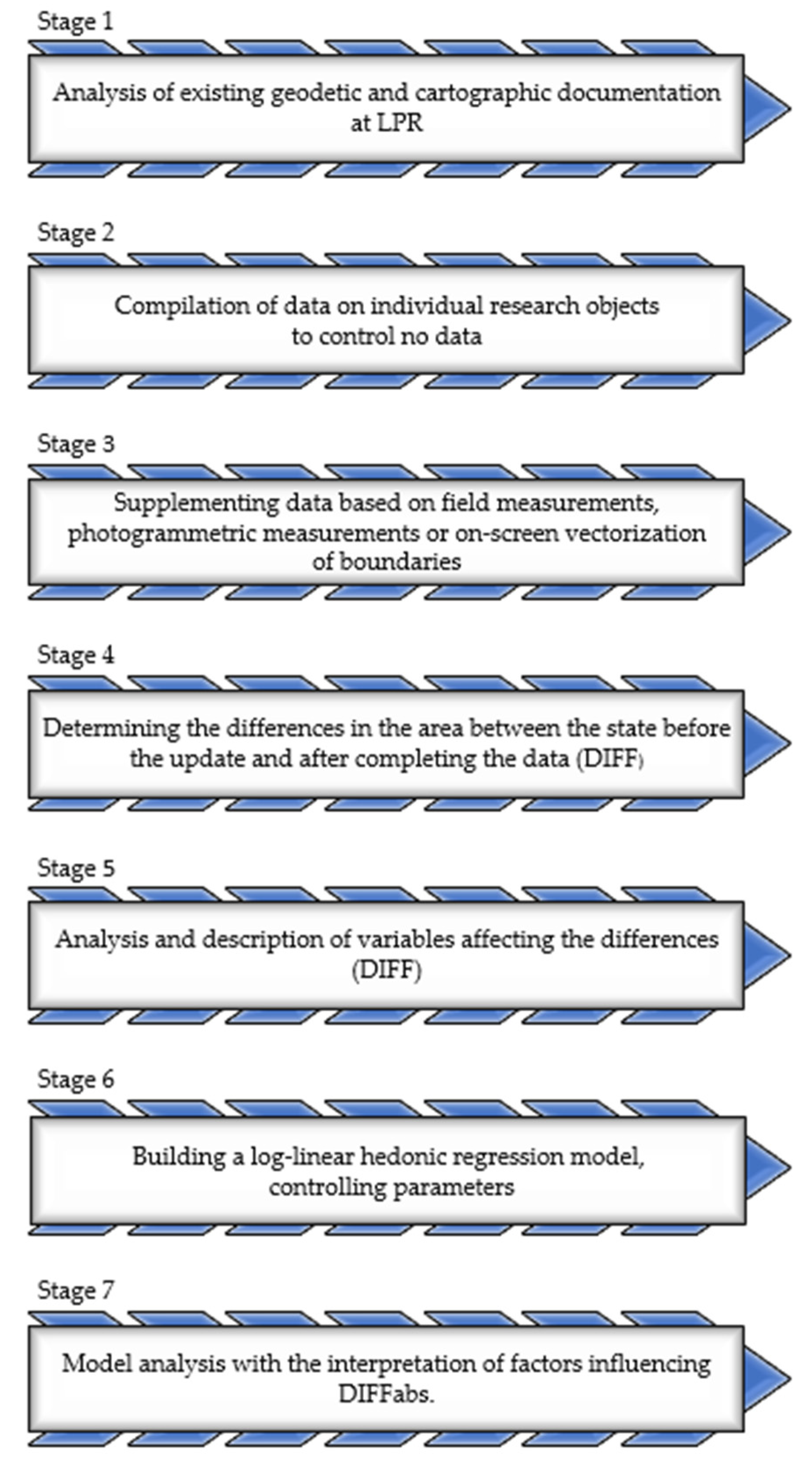
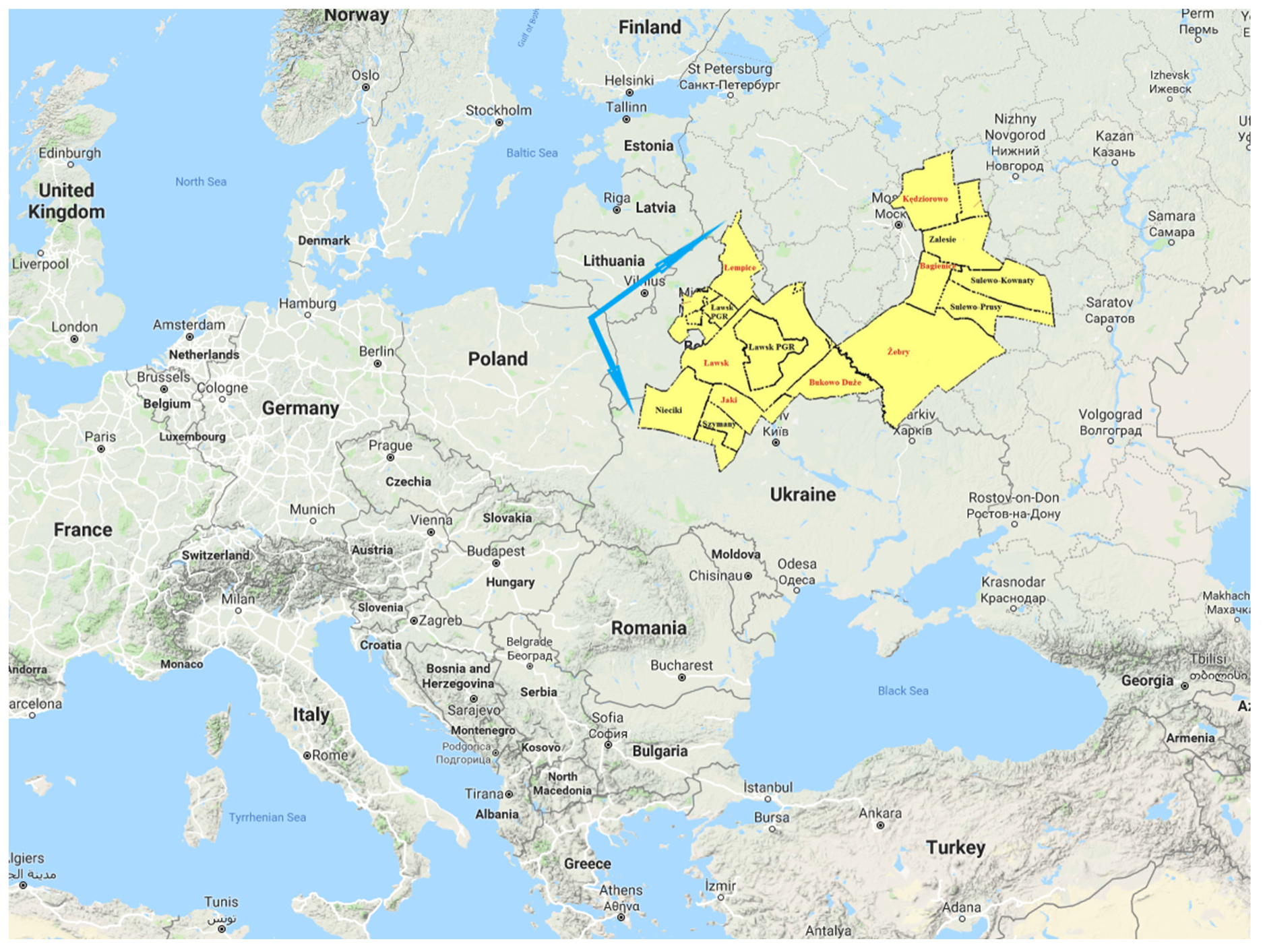
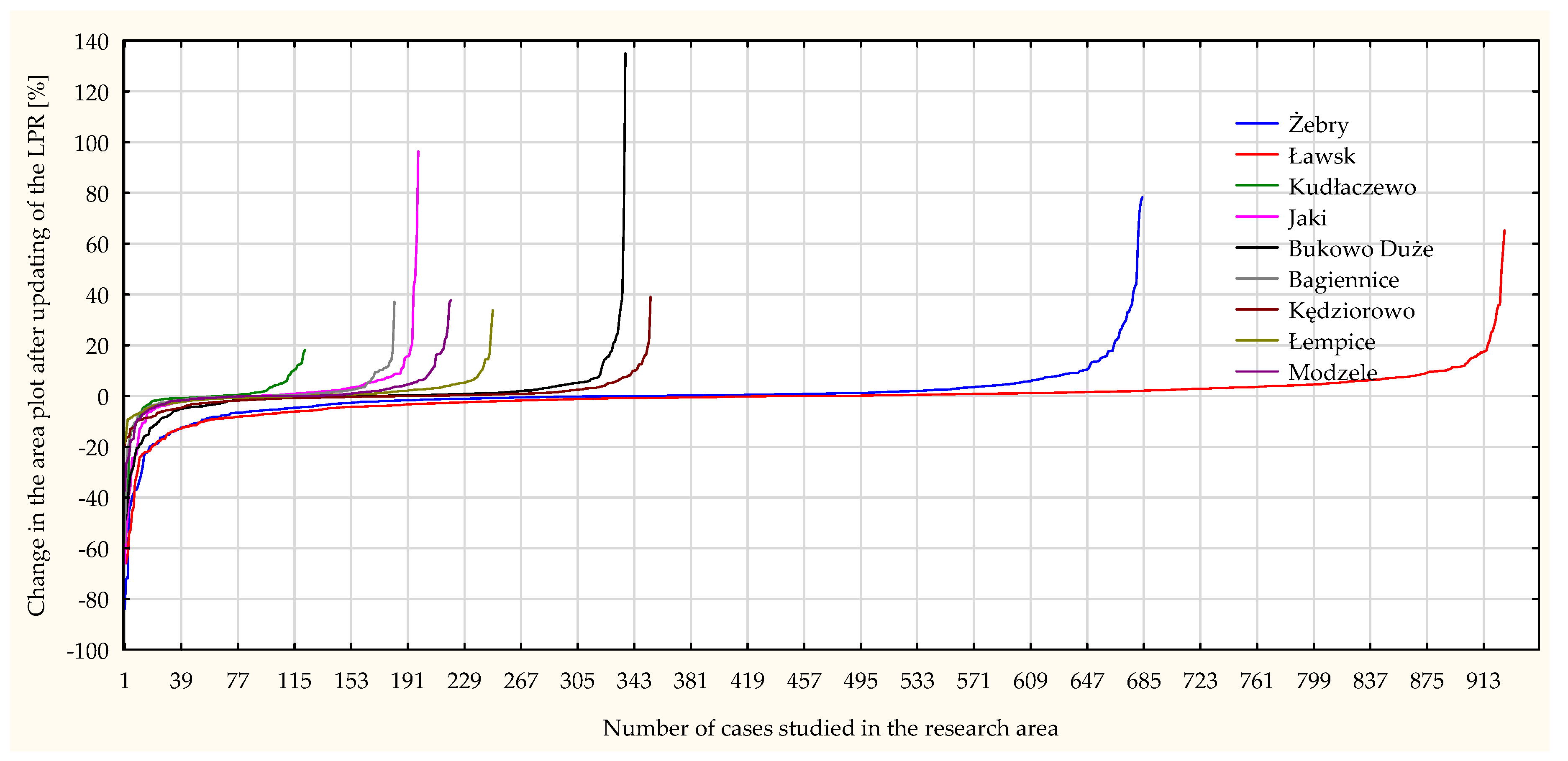
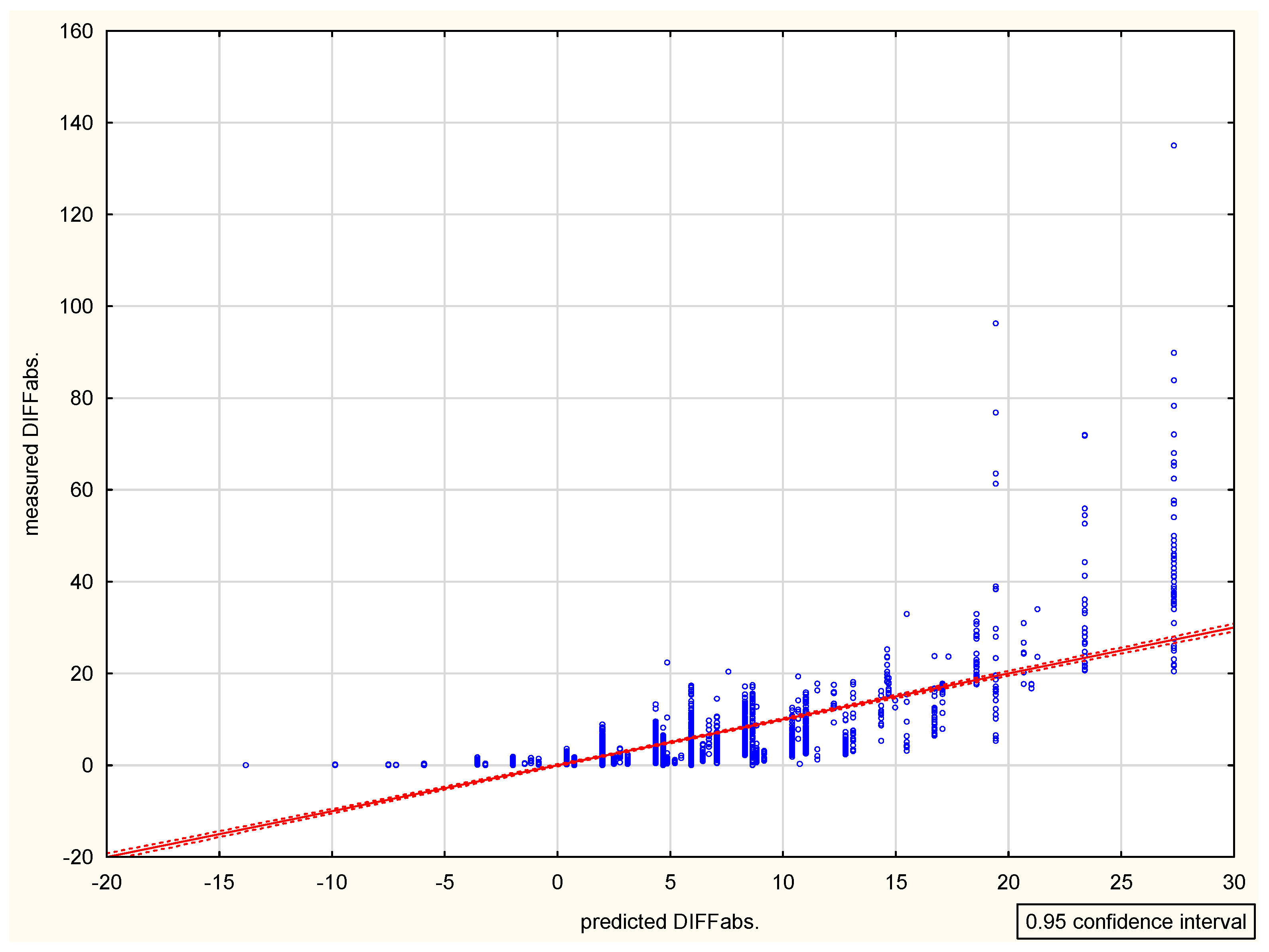

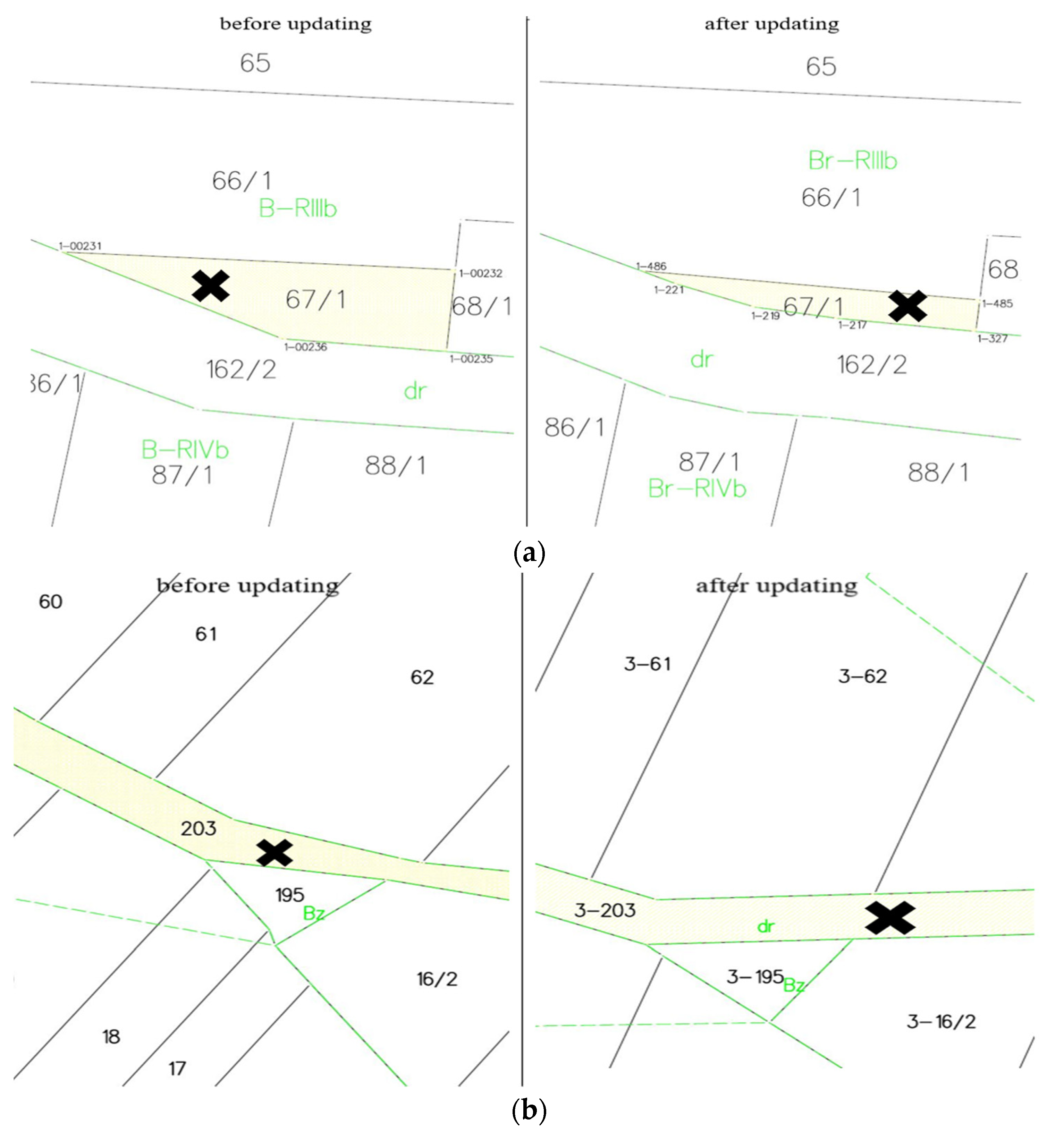
| Updating Data in the Land and Property Registry (LPR) | |
| Lack of Data Which Meet Technical Standards | There Are Credible Data Which Meet the Technical Standard (on Maps and on the Land) |
| Border Attributes | |
| −borders do not meet legal conditions, −borders cannot be shown on the land, −borders delimited with the use of the photogrammetric technology, but without the existing points of the geodetic control network; −delimited, but the existing documentation is incomplete, e.g., survey outlines contain partial information on borders and their measurements, consolidation, cadastral, division, unit plans, etc. −the borders are delimited based on the method of land use, but they have not been approved by means of a final administrative decision; −the borders have been approved by means of a final administrative decision, but documents which confirm their course in the field do not exist. | −delimited according to the legal status (approved in the administrative or court proceedings); −the border defined clearly in the geodetic documentation, −the border which can be shown on the land, −meeting the technical and accuracy-related requirements, −geodetic and border markers exist in the field; these can be mounds, posts, baulks, permanent development features, −borders created as a result of geodetic field surveys preceded by dividing up a real estate, restoration of border markers, mapping out border points or delimiting them in a different manner; −photogrammetric measurements preceded by determination of plots borders and their signalling or photogrammetric measurements of clearly identified border points; −approved plans of division and consolidation of real estate; −approved plans of consolidation and exchange of land. |
| Procedure of Delimiting the Plot Border | |
| −restoration of border markers—administrative proceedings as per Art. 39 (1) of [28] (moved, damaged, destroyed markers; a condition: legal documents exist which were identified earlier in administrative or court proceedings; it results in legal approval of the position of border points and lines) | −mapping out points disclosed earlier in LPR—Art. 39 (5) [28] (markers exist, there are legal documents established earlier in the administrative or legal procedure) |
| −delimiting the border of a record plot—§ 37–39 (no credible documentation; it does not result in legal approval of the position of border points and lines) [37] | |
| −dividing up a real estate—Section 6 [28] (delimitation of the border—it does not exist in the field or in documents; it results in delimitation of the borders as per the legal status) | |
| −delimitation of water bodies border (geodetic division of real estate; it results in legal approval of the position of border points and lines)—Art. 15 [40] | |
| −adopting real estate borders in in the division procedure [41] (originates when there is a need for regulation of ownership rights to real estate taken for roads; it results in legal approval of the position of border points and lines; documentation confirming the status on the land exists) | |
| Attribute | Description | Aver. | Min. | Max. | Sdev. |
|---|---|---|---|---|---|
| DIFFabs. | Percentage area change index [%] | 4.4638 | 0.00 | 135.00 | 8.5517 |
| SOURCE | Source of data on border point positions [1—data from earlier geodetic documents; 2—data from photogrammetric or field surveys; 3—data from screen vectorisation of the plot borders] | 1.5726 | 1.00 | 3.00 | 0.6677 |
| SLOC | A plot neighbouring a river, dirt road, forest, wooded area [1—a plot neighbouring a river, forest, dirt road, drainage ditch, etc.; 2—no special neighbourhood] | 1.7399 | 1.00 | 2.00 | 0.4387 |
| NBOR | Number of border points [1—a plot with up to 4 border points; 2—a plot with more than 4 border points (polygon)] | 1.1375 | 1.00 | 2.00 | 0.3444 |
| AREA | Plot area [1—to 1000 m2; 2—from1001 m2 to 5000 m2; 3—from 0.5001 ha to 2.0000 ha; 4—from 2.0001 ha to 5.0000 ha; 5—from 5.0001 ha to 20.0000 ha; 6—above 20.0001 ha] | 2.6761 | 1.00 | 6.00 | 1.0851 |
| Statistical Summary of the Quantitative Raw Data | ||||||
|---|---|---|---|---|---|---|
| Name of Village (Cadastral District) | Number of Cases | Average [%] | Min. | Max. | Average DIFFabs. [%] | Sdev. |
| Żebry | 684 | −0.2139 | −83.88 | 78.31 | 5.446 | 11.399 |
| Ławsk | 927 | −0.3638 | −66.00 | 65.33 | 4.639 | 8.783 |
| Kudłaczewo | 122 | −0.5173 | −45.00 | 18.14 | 4.254 | 8.622 |
| Jaki | 198 | 0.5766 | −66.00 | 96.34 | 6.029 | 13.633 |
| Bukowo Duże | 338 | −0.4069 | −50.00 | 135.00 | 4.850 | 11.904 |
| Bagiennice | 182 | −0.0774 | −57.67 | 37.00 | 3.386 | 7.406 |
| Kędziorowo | 354 | −0.1456 | −19.42 | 39.00 | 2.754 | 4.999 |
| Łempice | 248 | 0.5392 | −18.50 | 33.76 | 2.771 | 4.817 |
| Modzele | 221 | 0.6422 | −37.27 | 37.69 | 3.289 | 7.603 |
| Σ | 3273 | 0.0037 | −83.88 | 135.00 | 3.713 | |
| Log-Linear Model | ||||
|---|---|---|---|---|
| Independent Variable | Coefficient | Sdev. | t-Student | P |
| CONST. | 5.0641 | 0.00 | ||
| SOURCE | 0.4937 | 0.0148 | 33.1759 | 0.00 |
| SLOC | −0.1392 | 0.0122 | −11.4012 | 0.00 |
| NBOR | 0.2437 | 0.0146 | 16.6425 | 0.00 |
| AREA | −0.5014 | 0.0127 | −39.3517 | 0.00 |
| R | 0.7349 | |||
| Adjusted R2 | 0.5400 | |||
| Number of observations | 3273 | |||
| F(4, 3268) = 959.30 | ||||
© 2019 by the authors. Licensee MDPI, Basel, Switzerland. This article is an open access article distributed under the terms and conditions of the Creative Commons Attribution (CC BY) license (http://creativecommons.org/licenses/by/4.0/).
Share and Cite
Kocur-Bera, K.; Stachelek, M. Geo-Analysis of Compatibility Determinants for Data in the Land and Property Register (LPR). Geosciences 2019, 9, 303. https://doi.org/10.3390/geosciences9070303
Kocur-Bera K, Stachelek M. Geo-Analysis of Compatibility Determinants for Data in the Land and Property Register (LPR). Geosciences. 2019; 9(7):303. https://doi.org/10.3390/geosciences9070303
Chicago/Turabian StyleKocur-Bera, Katarzyna, and Marta Stachelek. 2019. "Geo-Analysis of Compatibility Determinants for Data in the Land and Property Register (LPR)" Geosciences 9, no. 7: 303. https://doi.org/10.3390/geosciences9070303






